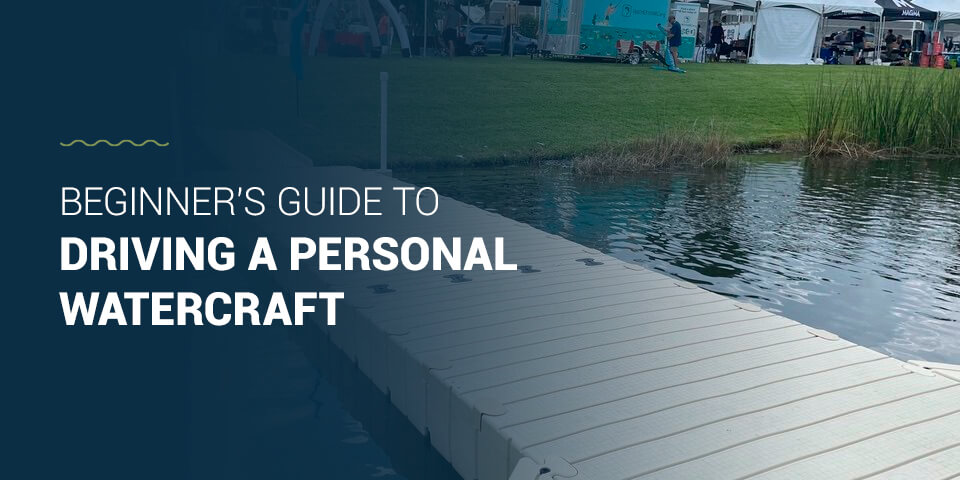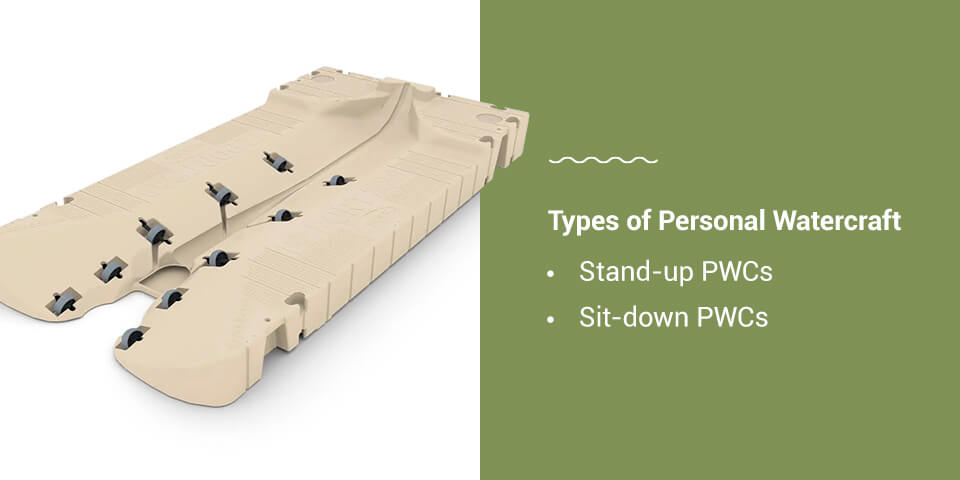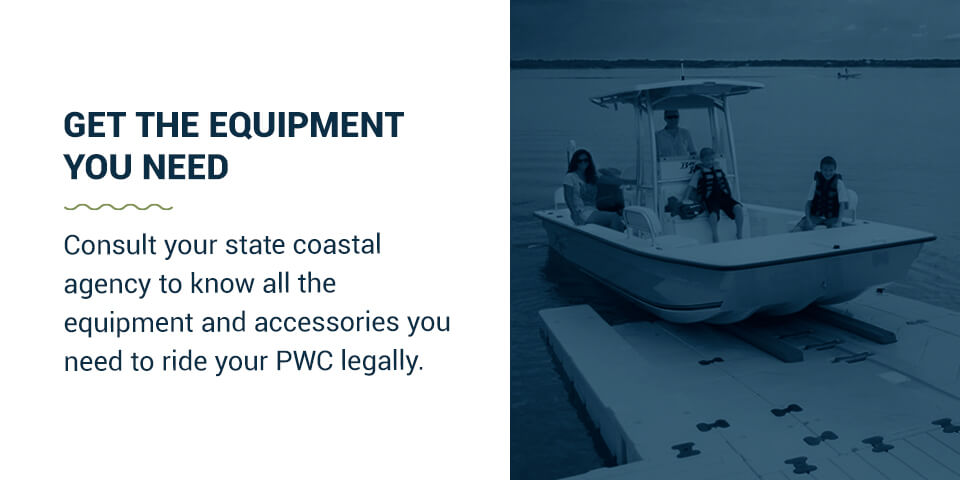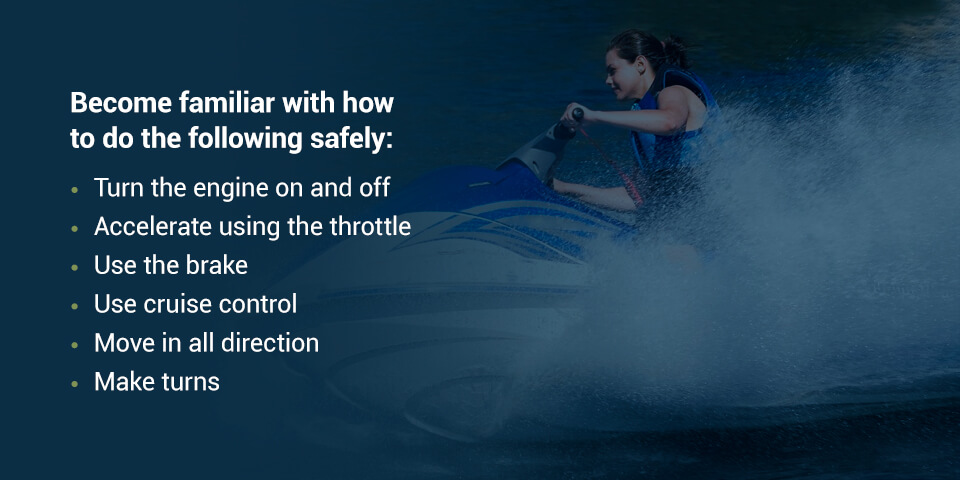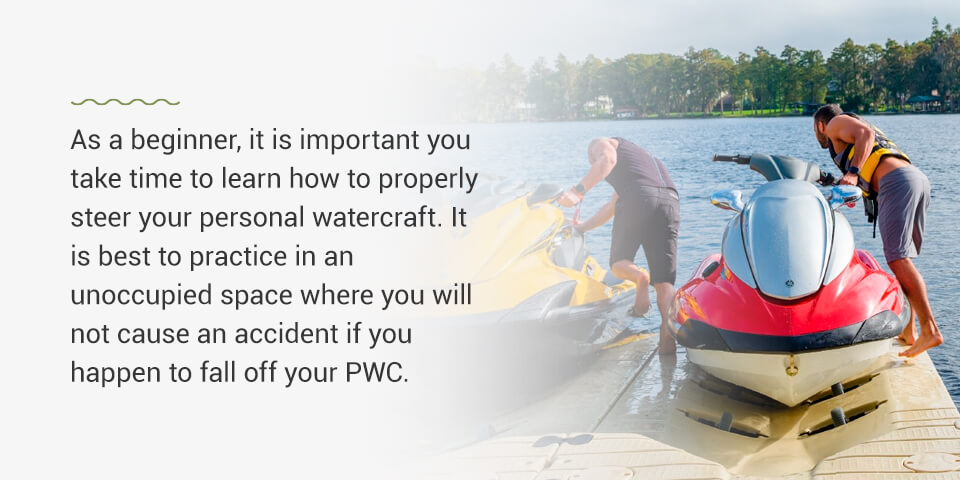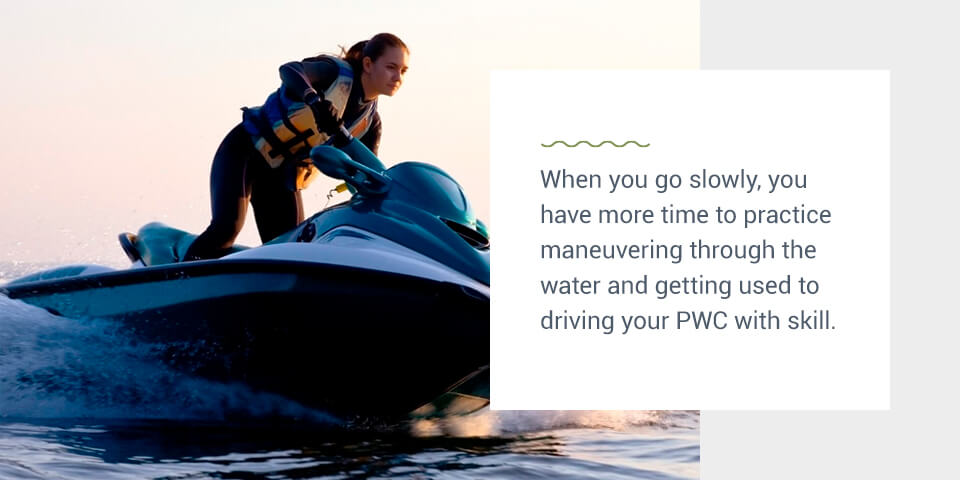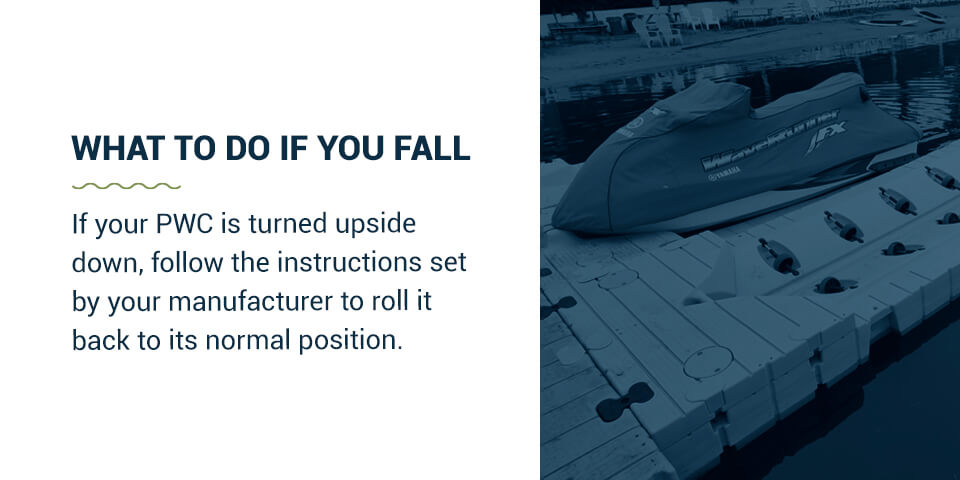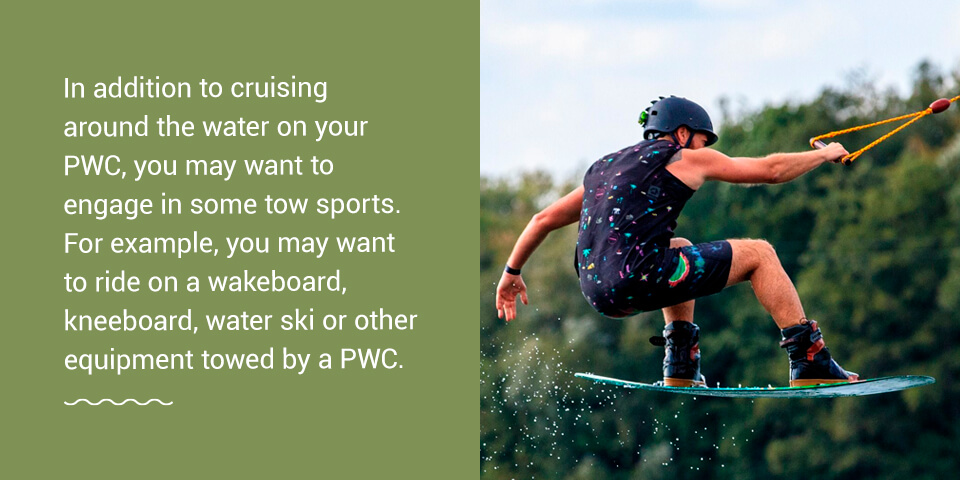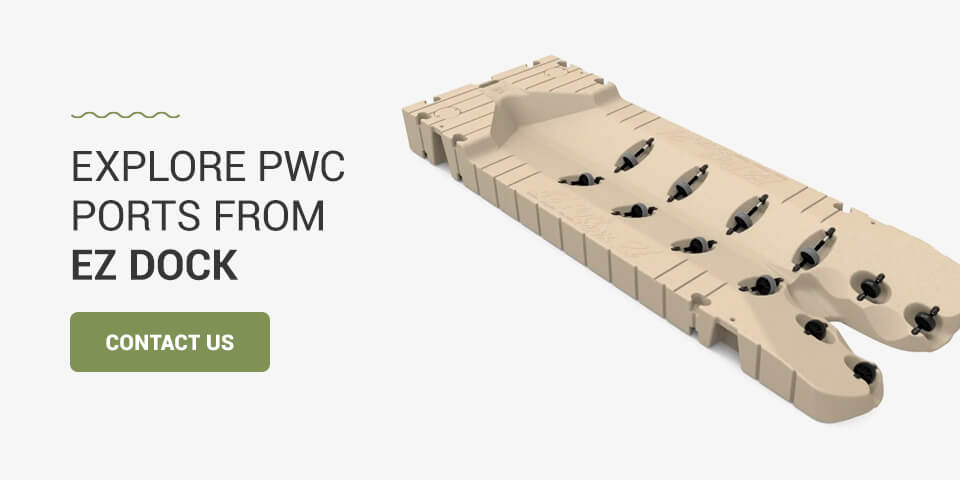Filters
Beginner’s Guide to Driving a Personal Watercraft
Are you looking to learn how to drive a personal watercraft (PWC)? There are many different factors to consider to ensure your journey to becoming a skilled driver is safe and fun.
We are breaking down everything you need to know before getting out on the water. From the best models for first-timers to the activities you can do once you’re comfortable with your PWC, we are sharing it all.
Learn more about driving a personal watercraft with this beginner’s guide.
Read the whole article or jump to a specific section:
- Types of Personal Watercraft
- Get the Equipment You Need
- Always Wear a Life Jacket
- Consider Taking a Boat Safety Course
- Use a Safety Lanyard
- Learn the Controls
- Be Aware of Your Surroundings
- How to Steer
- Using Cruise Control
- Sitting Vs. Standing Up
- Start Slow
- How to Handle Speed
- How to Stop
- What To Do If You Fall
- How To Dock
- How To Ride A Jet Ski, Sea-Doo or Wave Runner with Passengers
- Watch Out For No Wake Zones
- Tow Sports
- Wave Jumping
- Fishing
- FAQs About Driving a PWC
- Explore PWC Ports From EZ Dock Today
Types of Personal Watercraft
Before hopping on a PWC for the first time, it can be beneficial to explore the various types available on the market. The following are three popular PWC brands:
-
-
-
-
- Jet Skis by Kawasaki
- Sea-Doo by Bombardier Recreational Products (BRP)
- WaveRunner by Yamaha
-
-
-
Based on your position when riding and the number of passengers it can carry, there are two basic types of PWCs:
-
-
-
-
- Stand-up PWCs: Riders drive this style of PWC while standing upright. These models are a smaller option that can fit only one rider at a time. They’re a little easier to transport and often require less maintenance than large PWCs. A stand-up model is a good option if you plan on riding solo or intend to engage in active riding or racing.
- Sit-down PWCs: Riders stay seated on a sit-down PWC. They’re larger than stand-up models and can fit more than one rider at a time. Some options can accommodate up to four passengers and move or tow other objects on the water.
-
-
-
Get the Equipment You Need
What do you need to ride a Jet Ski, Sea-Doo or WaveRunner? When riding any type of PWC, there is some important equipment you’ll need to make the most of your adventure and to keep you safe.
There are federal safety requirements regarding the equipment you must have with you when driving a PWC, including:
-
-
-
-
- Life jackets
- Visual distress signals
- Fire extinguishers
- Backfire flame control
- Sound-producing device
- Navigational lights
-
-
-
In addition to this required equipment, it can be beneficial to bring along the following:
-
-
-
-
- GPS system
- First aid kit
- Sunscreen
- Eye protection
-
-
-
Consult your state coastal agency to know all the equipment and accessories you need to ride your PWC legally.
Always Wear a Life Jacket
When it comes to safely riding a personal watercraft, it is essential to wear a life jacket. You’ll want to ensure your jacket is approved by the United States Coast Guard.
It is important to check with your state and local laws to learn about the life jacket requirements in your region. PWC operators and those riding are legally required to wear an approved personal flotation device in many states.
Consider Taking a Boater’s Safety Course
In addition to what you will learn in this guide, consider taking a boater’s safety course before hopping on a PWC. Taking a boater’s safety course will give you a license to ride your personal watercraft. This is required to drive a PWC in some states.
Even when your state does not require it, taking the recommended boaters course will enable you to understand what you need to drive a Jet Ski or any other PWC as safely as possible. Plus, you’ll familiarize yourself with all the boating rules you have to follow in your state. Taking a course helps minimize injury and property damage risks.
Use a Safety Lanyard
Imagine falling off your Jet Ski, Sea-Doo or WaveRunner and it keeps riding away from you while you’re left behind in the water. It can be dangerous when this occurs, especially if you’re learning to drive where others riding or swimming.
A safety lanyard can help prevent this from happening. A safety lanyard is a cord that attaches your PWC’a ignition to you so that if you fall off your watercraft, the engine shuts down and the PWC stops. This automatic stop aids in accident prevention.
You can connect your safety lanyard to your wrist or life jacket if it has a clip.
Learn the Controls
Before jumping on your PWC and riding off into the water, it is best to learn all the parts of your watercraft and how to work with the controls. You can study your manufacturer’s manual to get a hang of this.
Become familiar with how to do the following safely:
-
-
-
-
- Turn the engine on and off
- Accelerate using the throttle
- Use the brake
- Use cruise control
- Move in all direction
- Make turns
-
-
-
Learning about the throttle on your PWC is essential. Releasing the throttle can inhibit your ability to turn your PWC and can lead to serious accidents.
Though some new models provide other controls outside of the throttle, like small rudders or other electronic control, the control provided by these other devices is usually minimal. It’s best to stick with mastering how to maneuver and steer your PWC with the throttle.
Also, some PWC models come with a learning mode feature that limits your speed and acceleration as a beginner. Consider using this mode in your first few days of riding. Study your manufacturer’s manual to get the hang of all the controls to operate your PWC effectively.
Be Aware of Your Surroundings
Once you know how to operate your PWC’s controls, you’re nearly ready to set out into the water.
As you gradually ride off the shore or dock and begin to feel the breeze on your face, don’t forget the need to be very aware of your surroundings. Keep an eye out for the following while you ride:
-
-
-
-
- Other riders
- Swimmers
- Larger vessels
- Animals
- Waterfront properties
- Shorelines
- Low water levels
-
-
-
Paying attention to your surroundings will help to ensure you ride safely. Awareness is key to preventing collisions and ensuring you don’t get in trouble with the law.
How to Steer
As a beginner, it is important you take time to learn how to properly steer your personal watercraft. It is best to practice in an unoccupied space where you will not cause an accident if you happen to fall off your PWC.
The key to steering a PWC is maintaining your speed. If you take your hand off the throttle before a turn, your Jet Ski, Sea-Doo or WaveRunner could surge straight ahead instead of in the direction you want.
Practice leaning into your turns and driving in all directions. Taking the time to practice steering can help you avoid accidents and refine your PWC driving skills.
Using Cruise Control
After mastering how to turn, you may want to enjoy a smooth ride without paying attention to how much you pull the throttle. This is where cruise control comes in.
The cruise control setting lets you ride your PWC at a constant speed without having to engage your throttle. As a beginner, this can help reduce stress on your hands as you work to master navigation.
One of the greatest benefits of using the cruise control feature on your PWC is relaxing your hands and fingers. While driving your watercraft, you can experience fatigue from holding down the throttle control for long periods. Turning on cruise control is a great way to avoid tiring your hands so you can continue enjoying your time on the water.
Sitting vs. Standing Up
You have a choice between a sit-down and a stand-up PWC. When learning how to drive, it can be advantageous to begin with a sit-down model where you can relax and get comfortable with the controls. As you become a more skilled driver, you can opt for either a stand-up or sit-down option.
Each style has its own benefits. The following are some of the key advantages of riding a sit-down PWC:
-
-
-
-
- Multiple passengers: You can have multiple passengers, including a skilled driver who can help with instruction.
- Comfort: These models let you drive in comfort, making it easier to practice your PWC’s controls.
- Storage: Sit-down models are often larger and have more storage space than stand-up PWCs.
-
-
-
Stand-up models require more skill and balance to drive, but they do have their own benefits, including being more agile in the water and more compact.
Start Slow
One of the most important rules of thumb for beginners is starting off slow. Don’t take off at a high speed on your first day. You have to become comfortable with your controls, and there are many things to keep in mind. When you go slowly, you have more time to practice maneuvering through the water and getting used to driving your PWC with skill.
Start very slow and increase your speed gradually. You never want to feel out of control or like your PWC is traveling at a startling speed.
How to Handle Speed
It can be really thrilling to hop on a Jet Ski, Sea-Doo or WaverRunner and glide through the waves at top speed. But that may be a silly move as a beginner.
The secret to handling speed is to start slow. Gain confidence in near-shoreline areas before zooming off at higher speed to the deeper and distal part of the river or sea. If your PWC has a learner’s mode, consider using it to avoid traveling too quickly.
Practice slowing your personal watercraft down and speeding back up. Doing so helps you really understand how to handle the speed with great control, keeping you and anyone else in the water safer.
How to Stop
Learning how to bring your PWC to a complete stop will vary depending on the age of your PWC model. Modern PWCs have brake systems that bring your watercraft to a halt when applied. But for older models, you stop your PWC by gradually decelerating till you come to a stop.
If you use an older PWC, learn to give ample distance between where you start decelerating and where you want to stop. This ensures you do not collide with any object at your destination. If you use a modern model, the best way to learn how to use the brake is to start with a low-speed brake application.
What to Do if You Fall
There is no need to feel embarrassed if you fall off your PWC. Even expert riders fall off from time to time. Just make sure to be careful when this does occur.
When you fall, do not try to get back on the PWC from the side. This could make you fall off again. If your PWC is turned upside down, follow the instructions set by your manufacturer to roll it back to its normal position.
Move toward the back of your watercraft and hoist yourself into your PWC from there. If you have a re-boarding step, you can use this to get back up onto your watercraft.
While trying to re-board, your PWC will sway from side to side, and the front might tilt upwards. Be careful when you do this to avoid potential injuries. After successfully getting on board, remember to connect your safety lanyard again before setting off.
How to Dock
After a fun ride, follow these steps to dock your PWC:
-
-
-
-
- Evaluate the situation: Consider the water conditions and if anyone is nearby.
- Approach the dock: Be sure to slowly drive toward the dock and anticipate coming to a complete stop.
- Pulse the throttle: Use your throttle in small spurts to help control steering.
- Come to a stop: Once you are beside the dock, stop your PWC and turn off its engine.
- Attach your PWC to the dock: You can dock your PWC using cleats and a line around your handlebars.
-
-
-
How to Ride a Jet Ski, Sea-Doo or WaveRunner With Passengers
After getting the hang of riding your PWC, you may want to experience the thrill with friends or family. Controlling your watercraft with passengers onboard can be a little tricky at first because you have to learn how to turn and maneuver with added weight.
Here are some tips to help you ride with passengers:
-
-
-
-
- Check with your manual first to see how many passengers you can safely have.
- Review safety measures with all your passengers.
- Inform your passengers not to make unannounced or sudden movements that may affect your control.
- Invite your passengers to lean or bend with you when making turns.
- Ask your passengers not to hang their feet out in the water when you’re in motion.
-
-
-
Ensure your passengers are properly geared with USCG-approved life jackets. Some states may require other passengers in your PWC who are not driving to complete some safety courses. Make sure your passengers comply with any legal requirements before getting on board.
Watch Out for No Wake Zones
It is fun to think of yourself speeding off in the waves, but you can only go so fast in a few parts of the water. There are areas where your riding speed is limited. These are the no-wake zones, and they include areas close to beaches and marinas. You should keep at least 150 feet between your PWC and the following:
-
-
-
-
- Swimmers
- Bathing beaches
- Boat launches
- Shorelines
- Docked watercraft
-
-
-
Tow Sports
In addition to cruising around the water on your PWC, you may want to engage in some tow sports. For example, you may want to ride on a wakeboard, kneeboard, water ski or other equipment towed by a PWC. Consult your coastal agency to know all that is legally required from you to engage in these activities.
Here are some things you should do to tow sport safely:
-
-
-
-
- Put on a life jacket.
- Lay out your hand signals.
- Using an appropriate, tow-approved PWC.
- Properly inspect your towing equipment.
-
-
-
Wave Jumping
If you want to engage in the adrenaline and fun-filled activity of wave jumping, there are a few things you need to know and do to remain safe.
First, ensure you have a good handle on your PWC and how to control it before you venture into wave jumping. When you want to practice, stay away from crowded areas so you do not collide with other riders, swimmers or watercraft. Face the wave directly, and do not let them hit the side of your PWC.
As you approach a wave you want to jump, do not underestimate the size of the wave. Stand above your seat by a few inches as you jump the wave, then go back down as your PWC settles. This will help you gain your balance after the jump.
Fishing
Beyond jumping and riding waves, you can also use PWCs for fishing. A major advantage of PWCs for fishing over boards and kayaks is the ease of movement they provide. With a Jet Ski, Sea-Doo or WaveRunner, you can easily fish in narrow channels or difficult places a boat may have difficulty accessing.
FAQs About Driving a PWC
The following are a couple of questions new riders often have regarding driving a PWC:
What Type of PWC Should I Choose as a Beginner?
We recommend choosing a sit-down PWC model for beginners. They are more comfortable to maneuver, and their compact size makes them easier to store.
How Do You Care For a PWC?
In addition to storing your PWC out of the water, here are a few simple things you can do to take great care of your ride:
-
-
-
-
- Clean and rinse out salt water after each ride
- Cover when not in use
- Perform regular maintenance
-
-
-
Things to Avoid
Here are some things you should avoid doing to stay safe on the water:
-
-
-
-
- Riding under the influence of alcohol or drugs
- Riding at night or in bad weather conditions
- Starting off at high speed
- Riding without a life jacket
- Learning in a crowded place
- Riding alone as a beginner
- Not studying the manufacturer’s manual before riding
- Forgetting to check fuel levels before heading into the water
- Starting your PWC in water lower than waist-deep
-
-
-
Explore PWC Ports From EZ Dock Today
If you were initially nervous about driving a PWC, we hope this guide has helped make you more confident and eager to use the next opportunity to go riding. Get yourself a PWC and enjoy the process of becoming a skilled driver.
EZ Dock has PWC docking solutions to enhance your experience and help you make the most of your time on the water. Our Ports for PWCs make docking your Jet Ski, WaveRunner or Sea-Doo easy. Request a quote or contact us today!

